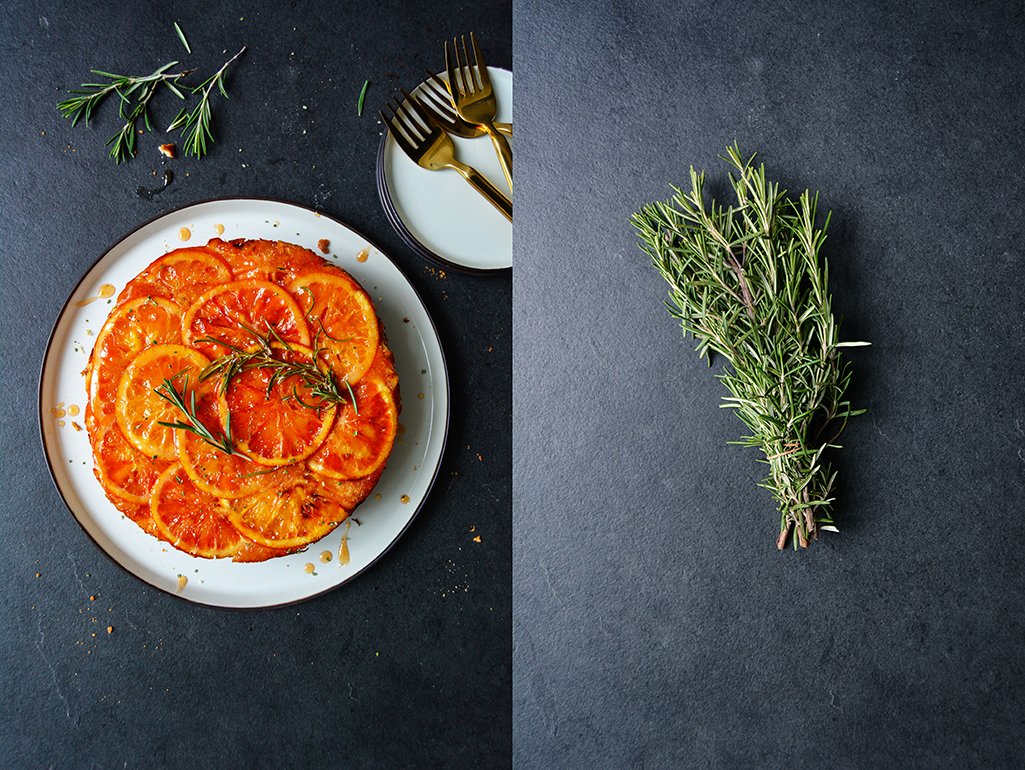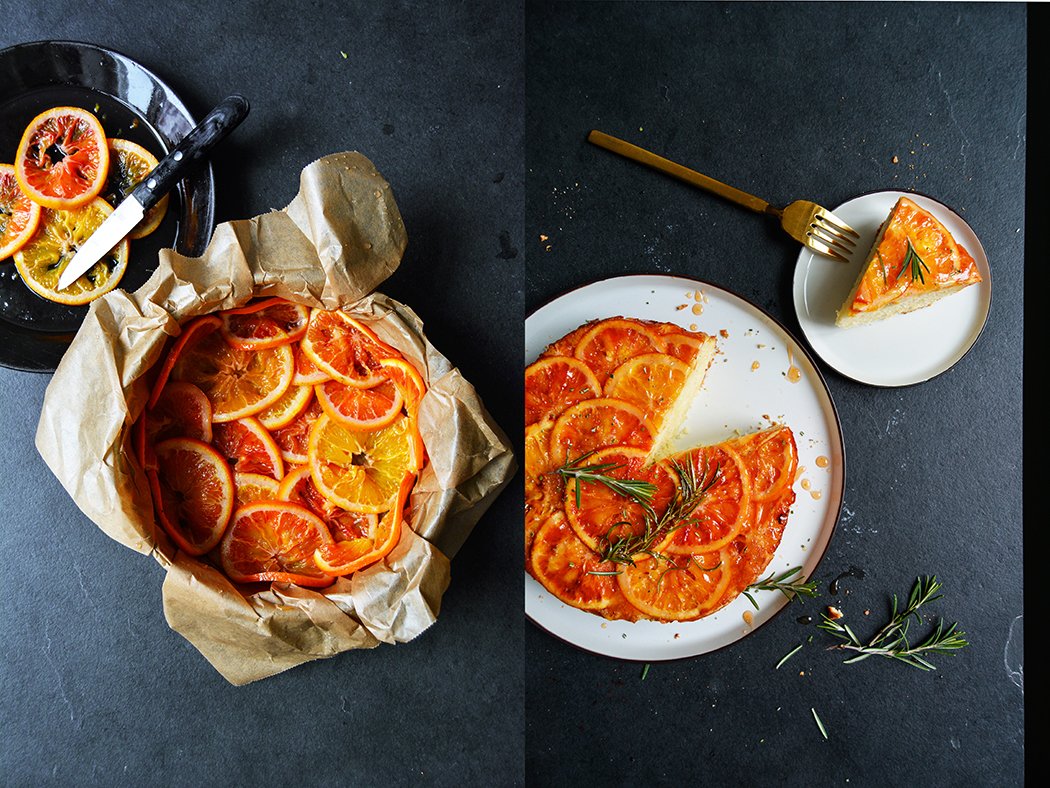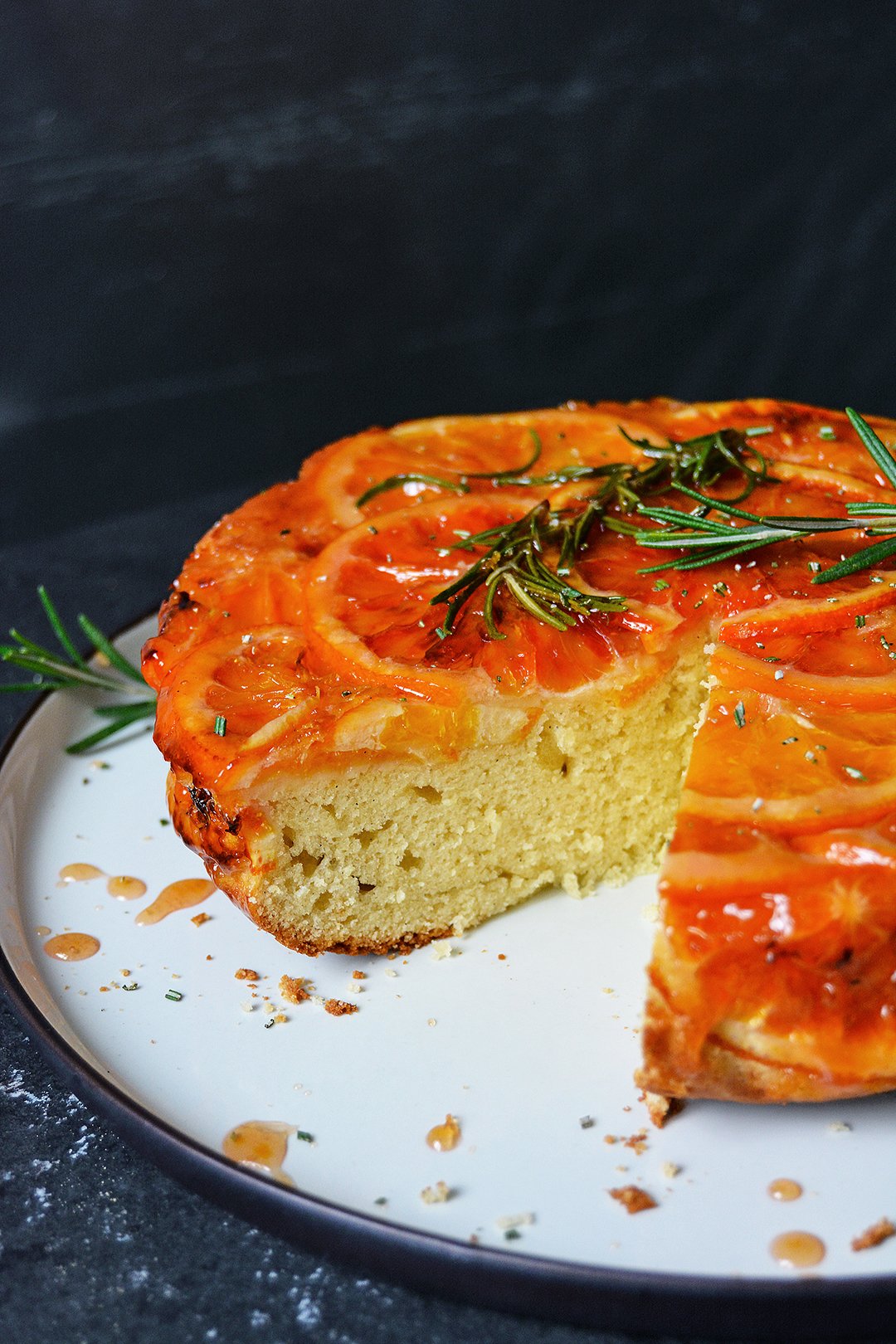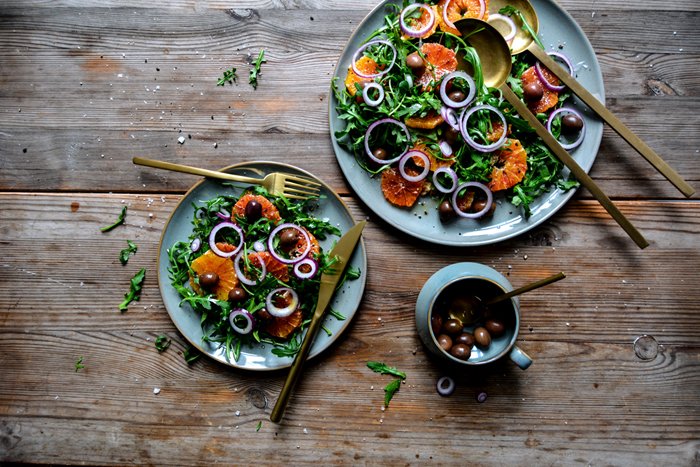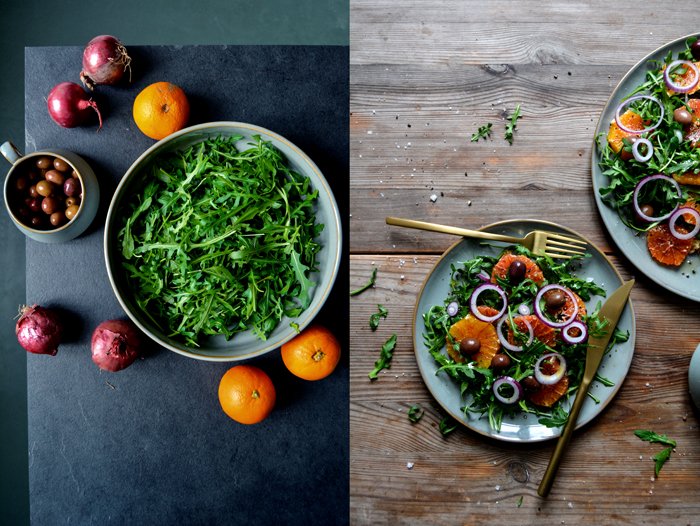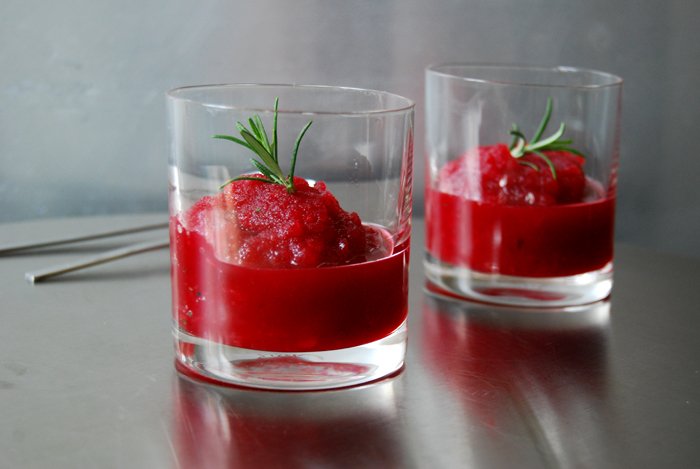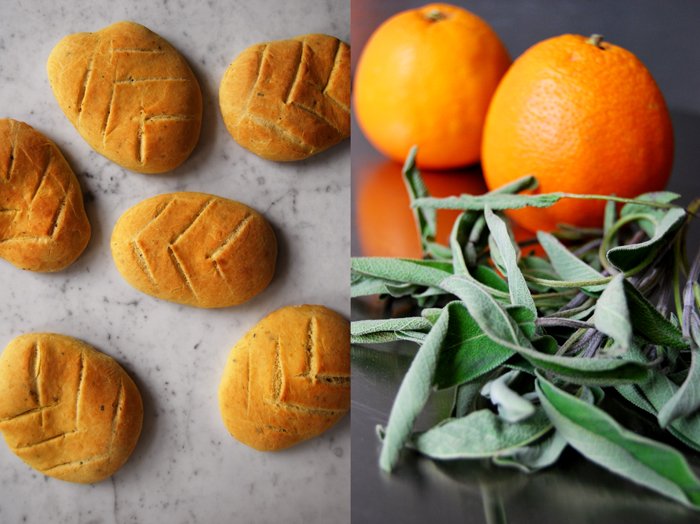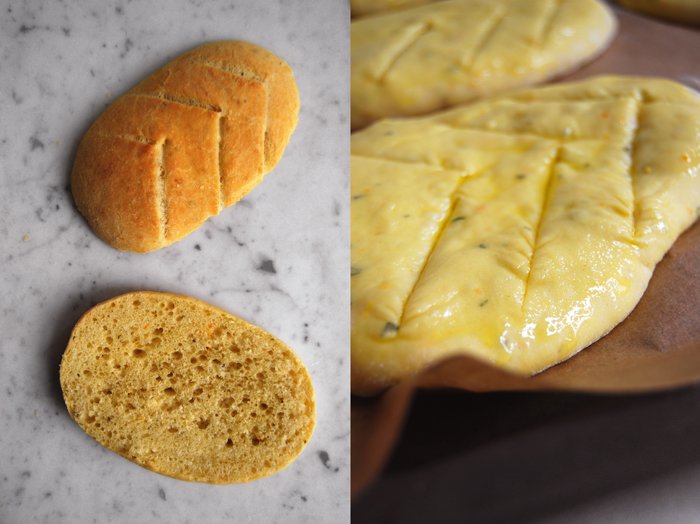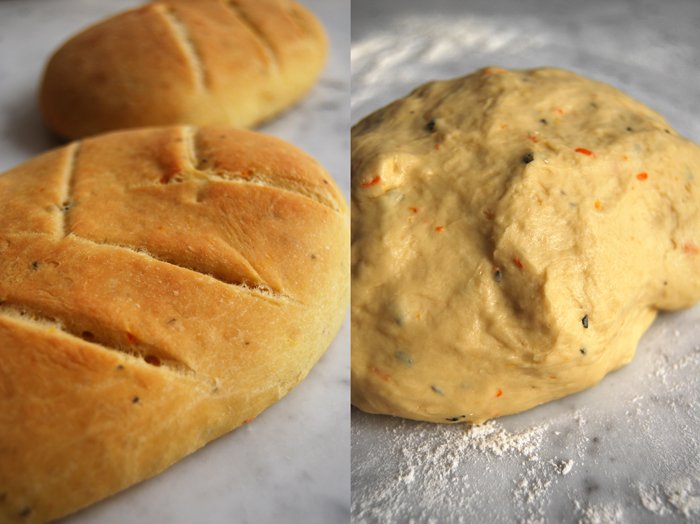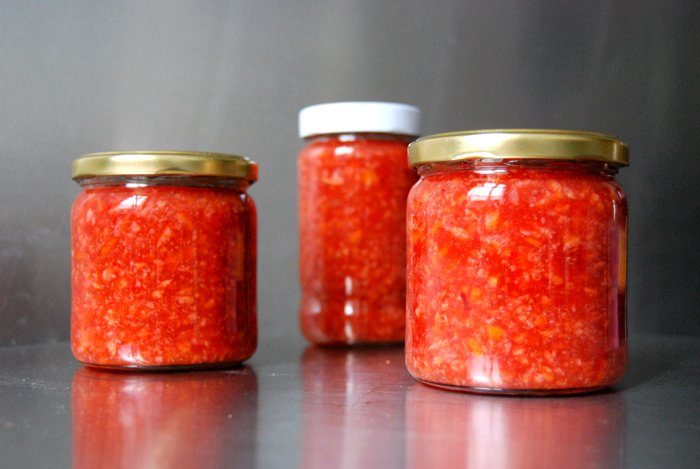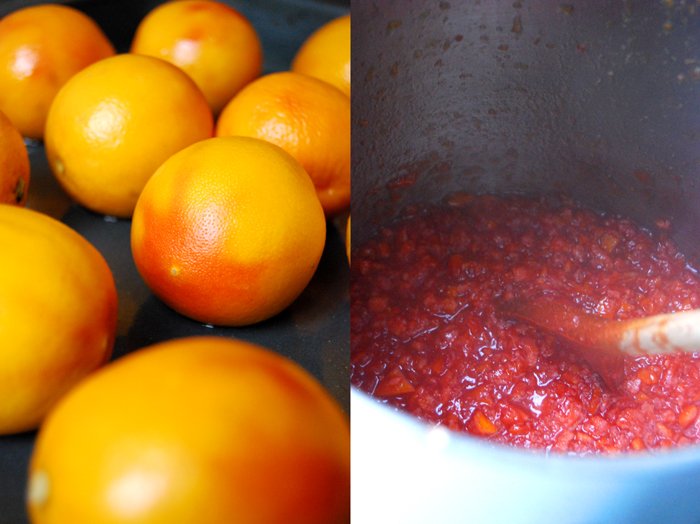Winter Caprese: Blood Orange, Beetroot, and Mozzarella di Bufala
I'm sure that I can smell it, I can hear it, if not even feel it on my skin. The promise of spring is in the air. The birds sitting on the naked branches of the tree in front of our living room window know more than us and they sing it out loud. Their voices vibrant and full of energy, they herald winter's nearing end.
With me, it's the same every year, I get impatient, frustrated. I can't wait to pull shorts and dresses out of my wardrobe, and sit outside in one of the city's cafés on a lazy Saturday afternoon, decadently sipping on a glass of chilled white wine. I want to see ripe tomatoes, lush basil, and plump peas on my kitchen table. I already dreamed of a colourful caprese salad waiting for me on a plate - and then I started to think "Wait, it's February, hold on!". But how about a little creativity and open mindedness, what about a winter caprese? There's mozzarella di Bufala in my fridge, sweet blood oranges replace the tomatoes, and boiled beetroot adds an earthy tone that goes unbelievably well with both the fruit and the cheese. I sprinkled it with a sweet date syrup vinaigrette, but maple syrup would be just as good, and a handful of fresh basil leaves (a hint of summer). It was one of the best lunches I've had in a while.
Tomorrow's the start of the crazy season again, carnival's back! If you're looking for some traditional sweet treats for yourself and your loved ones, try one of these sticky fried gems:
Winter Caprese: Blood Orange, Beetroot, and Mozzarella di Bufala
Mind that the beetroot has to cook for about 45 minutes.
Serves 2 for lunch or 4 as a starter
For the caprese
medium beetroot 1
bay leaf 1
small blood oranges, peeled and sliced, 4
mozzarella di Bufala, drained and torn into 2 or 4 pieces, 125g / 4 1/2 ounces
fresh basil leaves, a small handful
black peppercorns, crushed in a mortar (optional)
For the vinaigrette
olive oil 3 tablespoons
balsamic vinegar 1 tablespoon
white balsamic vinegar 1 tablespoon
date syrup (or maple syrup) 1/2-1 teaspoon
fine sea salt
ground pepper
Bring a medium pot of salted water to the boil, add the beetroot and bay leaf and cook for about 45 minutes or until the beetroot is tender (prick with a skewer to check). Rinse with cold water and let it cool; then peel and slice the beetroot.
For the vinaigrette, in a small bowl, whisk the olive oil, both vinegars, and the date syrup. Season with salt pepper and additional date syrup to taste.
Arrange the beetroot and blood orange in a circle on the plates, place the mozzarella in the middle. Drizzle with the vinaigrette (you might not need all the dressing) and sprinkle with basil and crushed pepper. Serve immediately.
Blood Orange and Rosemary Upside Down Cake
I already had my post written for today's bright orange Sunday cake, but then, yesterday's news from the US hit me. It felt so wrong to just write about a recipe, my mood, my day; why should I write about me and my food, when on the other side of the Atlantic, a single man throws everything away that our so called civilized world claims to stand for. How can we, or the president of the United States, ban citizens from certain countries (Iraq, Iran, Yemen, Libya, Somalia, Sudan, Syria) from putting their feet onto American ground?
I'm German, my country's history shows what happens when we tolerate and support the insane actions of a single man. Didn't we learn anything? Is it still possible for us to allow a man to run a country who doesn't show the slightest feeling of compassion? Didn't we, in the western world, hypocrites, arrogantly accuse other countries of exactly that?
Before I was sad, now I'm concerned.
And yes, I baked a cake. It's an upside down cake - for an upside down world - made with Sicilian blood oranges. It looks like a glowing Mediterranean sunset, peaceful. Some prefer to cut off the citrus fruits' peel, I leave mine on for a tangy touch. I first sliced and then cooked three fruits in sugar water with a sprig of fresh rosemary to infuse the pulp. About half an hour later they were soft, ready to become the fruity base of a light and fluffy upside down cake, thanks to beaten egg white folded into the batter. The citrus is very present, which I like, the herbal note is subtle. If you prefer you can use less fruits, but I recommend creating a thick juicy layer of orange slices. They keep the cake wonderfully moist and fruity, also on the second day.
Blood Orange and Rosemary Upside Down Cake
Makes 1 (20 1/2cm / 8") cake
For the oranges
water 120ml / 1/2 cup
granulated sugar 100g / 1/2 cup
organic blood oranges, rinsed, scrubbed, and the ends cut off, 3
medium sprig of rosemary 1, plus a few needles finely chopped (optional)
For the dough
plain flour 200g / 1 1/2 cups
baking powder 2 teaspoons
butter, at room temperature, 80g / 1/3 cup
granulated sugar 150g / 3/4 cup
organic eggs, separated, 2
vanilla pod, split and scraped, 1/2
milk 100ml / 1/3 cup plus 1 tablespoon
fine sea salt 1/8 teaspoon
Preheat the oven to 180°C / 350°F. Butter and line a 20 1/2cm / 8"springform pan.
For the oranges, in a large saucepan, bring the water and sugar to a boil over medium high heat. Stir and let the sugar dissolve. Cut the oranges into thin slices. Reduce the heat to medium, layer the orange slices in the sugar water, and simmer gently for about 25-30 minutes or until soft, but still in shape. Using a slotted ladle, transfer the orange slices to a large plate and let them cool for a few minutes. Add the rosemary to the pot with the orange syrup and set aside.
For the dough, in a medium bowl, combine the flour and baking powder. In a large bowl of a stand mixer, beat the butter and sugar until light and fluffy. Add the egg yolks and vanilla seeds and continue mixing for about 1 minute or until well combined. Quickly beat in the flour mixture in 3 batches, alternating with the milk. Beat the egg white and salt until soft peaks form and fold into the dough.
Arrange the orange slices on the bottom and sides of the prepared pan, fold some of the slices into the corners (see 2nd picture). Scrape the dough on top of the fruits, even it out and bake for about 35-40 minutes or until golden brown and spongy. Check with a skewer, it should come out clean. Let the cake cool for a few minutes before you flip it over, gently remove the parchment paper.
Bring the rosemary orange syrup to a boil over high heat and let it cook for about 2 minutes, let it cool for a couple minutes. Brush the top of the cake with the syrup and arrange the rosemary sprig on top. Sprinkle with a little additional chopped rosemary and enjoy!
Sicilian Blood Orange, Olive, and Red Onion Salad
The past mornings have been rather cloudy and grey and to make it even worse, they pulled my beloved wild vine off the wall opposite my kitchen window, which I used to call my vertical garden - the poor thing damaged the bricks. My little garden is gone. So the mood hasn't been very uplifting. And as I sat at the table in my kitchen, chewing over a new exciting meet in your kitchen features that I've been working on over the past few days and that I'm eager to share with you, I had to decide to postpone it. The feature was supposed to be up on the blog this week, but unfortunately, my guest from afar - Australia - is opening his second restaurant and so busy that we couldn't finish the interview yet. I felt a bit sad, or rather frustrated, because I adore his work and I'm so curious to read his answers and to get to know him a bit better. In these moments, I can be like a little child, impatient and not willing to accept reality - in this case: having to wait.
Food is the best cure for disappointment, at least in my case, so I looked around my kitchen to see what I could use to throw together for a quick and uplifting lunch. As I spotted a bunch of ripe blood oranges, I remembered a Sicilian salad made with the sweet citrus fruits, olives, and red onions. I added some rucola, olive oil, flaky sea salt, and crushed peppercorns and enjoyed the colourful plate in front of me just as much as the fresh taste of this delicious composition. Needless to say, my mood was much better after the first bite. The sweetness of the oranges merges perfectly with the spicy rucola and onions and the dark and oily depth of the olives. And it's put together in just a few minutes - it's a keeper!
Blood Orange, Olive, and Red Onion Salad with Rucola
Serves 2-4
fresh rucola leaves, 2 handfuls
small blood oranges, peeled (outer skin and white pith), cut into rounds, 4
small red onion, cut into slim rings, 1-2
black olives with pit 12-16
olive oil
flaky sea salt
black peppercorns, crushed in a mortar
Divide the rucola between plates. Lay the blood oranges, onion, and olives on top. Drizzle with some olive oil and season with flaky sea salt and crushed pepper to taste. Serve immediately, preferably with soft ciabatta.
Blood Orange Rosemary Sorbet
When I bought our ice cream maker a couple years ago, I didn't use it at first. I'm not crazy about ice cream although I have a sweet tooth and I can eat sweets all the time - if it's frozen I have to be in the mood. Things changed after I made my own first ice cream, I think it was strawberry, very creamy and far better, fruitier and less sweet than most I had tried before.
I always start my ice cream production in spring as I prefer to make it with fresh fruit, strawberry, blueberry, later in the year I use plums as well, everything sweet and aromatic finds its way into my ice cream maker. It's still quite early in the year and the temperature is far from summery but spring officially starts today, the perfect day to begin the production! Local berries aren't ripe yet so I have to think of something else. I find my inspiration in a frozen delicacy I love to eat in summer when we're in Malta, a fruity granita or sorbet! I love to walk along the promenade at the sea in the late afternoon when the sun is more forgiving, a cup of sour lemon granita in my hand, melting as soon as I dip the spoon into the crunchy bits of ice!
Today, it's not lemon but blood orange. I want to use them as long as they are still juicy and sweet. I'm in the mood for a sorbet with more complex flavours so I add a few chopped needles of rosemary. The result is delicious and the recipe a keeper, I will definitely make another batch soon!
Blood Orange Rosemary Sorbet
For 4 big portions of sorbet you need
freshly squeezed blood orange juice 500ml
juice of 1 lemon
icing sugar 50g / 2 ounces
fresh rosemary, finely chopped, 2 teaspoons
Mix the ingredients well and put into an ice cream maker for around 25 minutes until almost frozen. Serve immediately or keep in the freezer.
A Monday Morning Juice with Grapefruit, Banana, Orange and Ginger
I have the tendency to become overly excited as soon as the temperature rises above 10°C and the sun comes through for more than a couple hours. I know it's only the beginning of March but I already feel like spring. I want to get out my summer clothes and jump around in the springy, fresh air. I want to sit outside a café with a glass of chilled white wine, enjoying the warm sun. Unfortunately, there's still a gap in temperature between my dreams and reality which I don't want to accept (sometimes) and that's exactly the problem! I'm prepared for the coldest winter and arctic temperatures, I never get a cold, but at this time of the year, a stone's throw away from the end of the cold season, I tend to be too carefree and strain my immune system.
To avoid any deficit in vitamins, I start the week off with a powerful juice made of grapefruit, banana, blood orange and ginger. For two glasses of juice (400ml in all), I squeeze 1 pink grapefruit and 3 oranges. I add 1/8 teaspoon of grated ginger and half a banana, mashed smoothly with a fork. You can use a whole one but I didn't want its taste and sweetness to be too overpowering.
It's a true energy boost, like my January's Turmeric and Ginger Blood Orange Juice!
Fougasse Bread with Orange, Sage and Olive Oil
It's time to bake bread again! I use a recipe which involves sage and my beloved blood oranges, they'll be out of season soon, so I'm using every possible occasion that allows me to cook or bake with my sweet citrus fruits. I mix generous amounts of their zest and juice into the dough and the result is impressive!
My bread is a light and aromatic Fougasse, a French flatbread very popular in Provence where it's often made with olives, herbs and cheese. It's similar to the Italian Focaccia but with a leaf pattern of cuts in the dough. In some recipes, the cut goes all the way through creating holes in the bread while it's baking which makes the bread harder. I prefer to leave mine juicy with shallow cuts on the surface. Besides the orange and sage I add good olive oil in and on the bread. I use the wonderful extra virgin olive oil from the Molise region which I got from Marilena. Its strong and fruity taste is just what my Mediterranean flatbread needs!
I already have a great idea for a sandwich I can make with this bread for tomorrow's Sandwich Wednesday!
Fougasse with Orange, Sage and Olive Oil
For 6 flatbreads you need
plain flour 400g / 14 ounces (I use spelt flour type 630 but you can use any other plain flour)
dry yeast 1 package (for 500g / 1 pound flour)
salt 1 teaspoon
fresh sage, chopped, 8-10 leaves
zest of 1 medium sized orange
freshly squeezed blood orange or orange juice 100ml
water, lukewarm, 100ml
olive oil 5 tablespoons plus more for brushing the bread
organic egg 1
Combine the flour, yeast, salt, orange zest and sage in a large bowl. Add the water, orange juice and egg and mix with your dough hooks for 5 minutes. On a floured surface, continue kneading with your hands for a few minutes until you have an elastic dough ball. Put the dough back into the bowl and cover with a tea towel. Let the dough rise in a 35°C / 95°F warm oven for 45 minutes. This works really well but make sure that your oven is set to top/ bottom heat and not to fan.
Take the dough out and punch it down. Divide it into 6 pieces and roll them out into egg shaped discs (on a floured working surface, around 1 1/2 cm / 1/2″ thick). Put them on a baking sheet lined with parchment paper, cover with a tea towel and let them rise for 20 minutes.
Set your oven to 210°C / 410°F.
Brush the flatbread with olive oil and cut a pattern of 6-8 diagonal slashes into the dough to make a leaf pattern. Bake the flatbread on the lowest level for 12-15 minutes or until golden brown. Take them out and let them cool for 2 minutes.
I cut the warm flatbread in half and drizzled some more olive oil over it, it merged perfectly with the orange and sage aromas!
Sunset in a Jar - Blood Orange Marmalade
This red is just stunning. It's like the brightest red sunset caught in a jar! I'm hooked on blood oranges, I have them all the time, as a snack or as fresh juice. They are so sweet and juicy at the moment that I much prefer them to normal oranges or tangerines even. I buy huge bags of the Italian ones, now that they are in season, organic with thin skin, and I think I could live off them (for now).
All good but I want to bring some variety in, therefore I decide to put them in a jar and made some blood orange marmalade. I've never made it before but so far my marmalade recipe worked very well with Seville oranges and tangerines, so why not with blood oranges (I wrote about my tangerine marmalade in December)? It worked, and more than that, the result is amazing! This marmalade is so sweet, yet slightly bitter, it's just right! I spread it on a slice of white English bread, impatiently, it just finished cooking, and I couldn't stop smiling.
Blood Orange Marmalade
For 3-4 medium sized jam jars you need
organic blood oranges, rinsed, 1200g / 2 1/2 pounds
granulated sugar 600g / 1 1/4 pounds
juice and seeds of 2 lemons
spirit to sterilise the rims of the jars
Sterilise the 4 jam jars in boiling water for 5 minutes.
Fill a large pan with water and bring to the boil. Cook the oranges for 25 minutes or until soft (mine needed 25 minutes but they were small with thin skin). Take them out and keep some of the water.
Quarter the cooked oranges (don’t peel them, you use the whole orange!), take out their seeds and put them aside (you will need them). Cut the lemons in half and keep their seeds as well. In a small pan, heat up some of the blood orange cooking water (it should come up to 2cm / 3/4"), add the lemon seeds and orange seeds and let them cook for 5 minutes.
Shred the quartered oranges in a food processor for a few seconds. Put them in a large pan, add the sugar, the lemon juice and the water used to boil the seeds. Bring to the boil gently (the sugar has to dissolve first) and boil for 18-20 minutes.
Dip the rim of your jars in the spirit and wash out the lids of the jars with the alcohol as well. Fill your jars with the marmalade and close well immediately.







